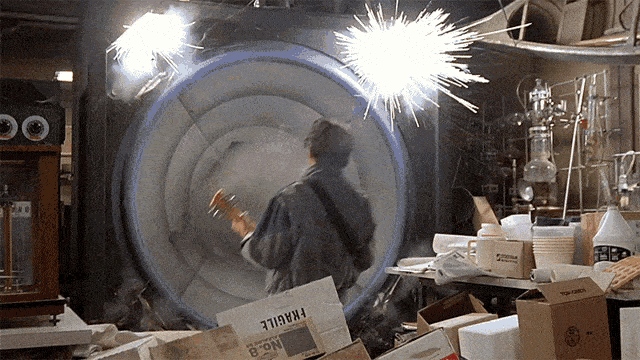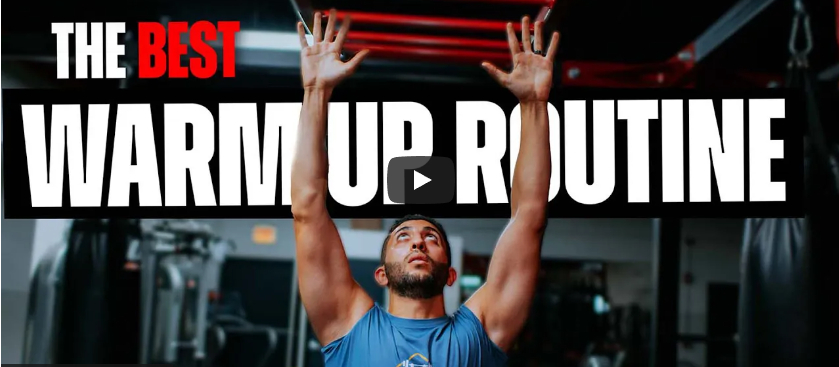I think a lot of people like to look at warming up as optional, probably because it’s not as exciting as lifting the actual weights. I couldn’t agree more! It can be boring and dull. Sometimes I’m just going through the movements, but without going through these movements, I’m not going to be able to do the workout as well as I want to.
We all want to lift heavy because it’s going to help us get the most out of our bodies, it’s going to improve our joint health, it is going to minimize the amount of fat on our body, improve our metabolisms, help us build more muscle, and just feel better, stronger and more confident overall.
If you’re not warming up properly to get to that main lift, you’re setting yourself up for injury, if not immediately, maybe somewhere down the line.
You may also be putting yourself in a position where you’re going to have nagging shoulder aches, elbow aches, and wrist pains. A lot of people experience this and it’s normal but that doesn’t mean it’s all right to experience it! You don’t have to go through your day-to-day life as a casual lifter, as a hobby bodybuilder or whatever you do, feeling aches and pains all the time. It’s not something you should be experiencing.
By the end of this you’ll understand
- The importance of warming up
- The worst ways to warm up
- What you should do instead
You will be given a couple of options for that, and you get to choose what’s going to work best for you. Feel free to watch the full-length Youtube Video or continue on to the article below
If you go to the gym, and you survey 10 people, odds are, a good number of them are going to have some sort of low back pain, knee pain, shoulder pain, or wrist pain.
That is very common to experience, but it doesn’t have to be. 9 out of 10 times, all of those injuries can be prevented with the proper warm-up and mobility phase.
The reason you want to warm up, and actually get your body through the priming and activation phase, is so that your body can be ready to do the most that it could possibly do during your training session. I always like to make the analogy that the warm-up phase is basically setting up amps on your speaker.
You could listen to stuff through a speaker without connecting it to an amp, but it’s not going to be as good quality. The sound is going to be missing something and it’s not going to be the same experience as it would with an amp.

In this situation, the priming activation aspect of your training is the amp. Without the amp, you could still listen to music but you’re not getting the full experience – something is always lacking. It’s the same thing with your training, you could technically do your workout without the warming up part, but you’re always going to be missing something. You’re always going to be leaving results on the table every time you work out if you’re not doing your warm-up.
In this situation, your central nervous system is the amp. This is what’s going to help connect your brain to your muscles. This helps you to move as effectively as possible, as explosively as possible, and use your muscles to the fullest potential. You want to get your central nervous system amped up, and ready to lift heavy weights because otherwise, you’re not going to be able to lift as heavy as you can. You’re going to put yourself in a position where your joints aren’t going to be ready for movement.
I think a lot of people like to look at warming up as optional because it’s not as exciting as lifting the actual weights, and I agree with you. It is boring and sometimes dull, Sometimes, I am just going through the movements, but without going through these movements, I’m not going to be able to do the workout as well as I want to. You have to recognize that this isn’t separate from your training, it is a part of your training, just as much as squatting, benching and deadlifting is.
There are a couple of ways by which you can amp up your central nervous system to get ready to lift heavy weights and perform well in the gym.
Here are some ways people like to warm up that aren’t quite as effective as they could be.
3 Common Ways People Warm Up (That Aren’t Right)
1. A person goes into the gym:
- The person warms up
- They move their joints around
- They’re about to bench
- They do the rotator cuff thing where they rotate their arm in and out with a little 2.5 dumbbell
- They move their shoulders around just to loosen up
- They get into their compound movement
Their bench, their overhead press, or whatever else they’re going to do is cool. It’s not bad since you’re getting your joints moving, you’re also getting them ready to work out, but you’re leaving a lot on the table. This is because your joints are only a part of this, your central nervous system isn’t amped up, your muscles aren’t primed and ready to go, or even warmed up for the movement.
Since you haven’t loaded your muscles yet, you won’t be ready to lift the big weights you want to lift in that training session because you’re only warming up your joints.
2. Person two:
- Walks in
- Throws their bag next to the squat rack
- Chugs a bang that they just bought at the front counter
- Does 15 warm-up sets for their squats before ultimately doing three actual working sets
This person didn’t go through a warm-up. They just went right into the compound movement, started adding weight slowly over time, and then got into their actual training set. They didn’t have a warm up, which isn’t smart, they didn’t prime their central nervous system, and they fatigued themselves early before getting to the max weight, which limits how much weight you could lift later on. There were a lot of flaws here but at least this person was cautious at the beginning. Ramping up the weight put this person in a position, before going into the heavyweights.
3. Person three: the worst of them all…
- This person parked the car outside
- Ran to the gym and straight to the squat rack
- These people put on the heaviest load they can because they don’t think they need to warm up, they’re too good to warm up, and they’re a “seasoned veterans” in the gym so they don’t have to do any of that
The third one’s obviously the worst one, definitely the highest risk of injury by far. The first two, not too bad, could be a lot worse, but it’s not getting the most out of the workout as it can be.
LET’S LOOK INTO WHAT A PROPER PRIMING ACTIVATION AND RAMP-UP LOOK LIKE FOR YOUR TRAINING
How To Mobilize & Prime For Your Main Lift
Before getting started with your main compound lift of the day, it’s important to take the joints and muscles that are going to be worked through an explosive activity to get your heart rate up.
It is important to get the blood flowing, raise your core temperature and amp up your central nervous system. The explosiveness is key here in doing that.
Some example priming exercises for the most common compound lifts are going to be for:
Bench Press Warm-Up
a) Joint Mobilization: My favorite for upper body is the Band Giant Set (Video Here)
b) Activation & Priming: There are a few options for this:
- Speed bench press- benching a light amount of weight for 3-5 reps as fast as you can (Video Here)
- Plyo push-ups – basically “jumping” push-ups that you can do from the floor or bench (Video Here)
- Medicine Ball Chest Pass – this gets you going through that movement pattern as explosively as you can (Video Here)
Squat Warm-Up
a) Joint Mobilization: Lower body mobilization is more complex than the upper body, this video is a good walkthrough of the exercises to follow
b) Activation & Priming: You want to do explosive knee flexion movements, things like:
- Squat Jumps or Weight Squat Jumps – The goal is to get as high as you can! (Video Here)
- Sprinter Jumps – These are one-legged squat jumps – same goal! (Video Here)
Deadlift Warm-Up
a) Joint Mobilization: Lower body mobilization is more complex than the upper body, this video is a good walkthrough of the exercises to follow
b) Activation & Priming: This is a hip hinge movement so we want explosive hip hinging before heavy lifting, things like:
- Kettlebell Swings – The magic is in driving the hips forward while keeping a straight back (Video Here)
- Broad Jump – To get far you really have to drive those hips forward, focus on that! (Video Here)
Overhead Press Warm-Up
a) Joint Mobilization: My favorite for upper body is the Band Giant Set (Video Here)
b) Activation & Priming: There are a few options for this
- Kneeling Push Press – Explosively extend arms overhead! (Video Here)
- Wall Balls.- Toss that thing as high as you can! (Video Here)
Once you’ve got your joints mobilized and your CNS primed we can get into the main compound lift! Before lifting your heaviest set though, you have to build up to it (especially if it’s a lot of weight) let’s break down the most effective way to do that
How To Ramp Up To Your Lifting Weight
Let’s say you’re going to bench 200 pounds your in you’re workout, you don’t immediately put 200 pounds on the bar, you need to slowly ease into it but the way people ease into it is pretty off most of the time.
Let’s say you’re trying to get to 200 pounds, the average person will likely:
- Start at 100 pounds for 15 reps
- Add another 20 Pounds, do it for 12 reps
- Add another 20 pounds, do it for 10 reps
- Add another 20 pounds, do it for 8 reps
- Then finally they’re do their 3 sets of 6 reps at 200 pounds, four sets later, after doing 30+ reps, and taking 20+ minutes.
That is so much extra and wasteful volume. By the time you get to your main lift you’ve already fatigued yourself to a point where you won’t be able to perform the exercise to your fullest capacity because you’ve accumulated so much fatigue.
Instead you want to slowly increase weight while DECREASEING reps!
The real goal is to get your body used to lifting the heavier load, you don’t need to rep it out and tire yourself out before getting to that point. To build to the top set properly, do this instead: maybe instead:
- Start at 100 for 8-10 reps
- Move up to 140 for 5-6 reps
- Move up to 180 pounds for 2-3 reps
- Then you can start lifting your working set and doing 200 pounds at 6-8 reps.
This way, you won’t tire yourself out, you’ll be able to do the actual top sets as effectively as you can because you didn’t pre-fatigue yourself.
Stoopid Simple Summary
When it comes to warming up properly, you want to avoid doing the following:
- Don’t do five plus sets of warming up, slowly adding weight and keeping the reps really high
- Don’t focus on joints only
- Don’t jump right into the gym
Instead, you want to be specific with your execution:
- Go through as many mobility exercises as you need to loosen up and get the joints working.
- Then do a priming exercise that is explosive and similar to the movement pattern that you’re going to be doing for that day
- Finally, when doing the ramp up sets, just do a few sets, slowly increasing the weight, but decreasing the reps as you go up.
You don’t want to fatigue yourself before getting to the top sets, and getting yourself tired before you can actually do the most important part of your workout. Try this out for a few weeks and I guarantee you’ll be putting up more weight than you ever have before!







